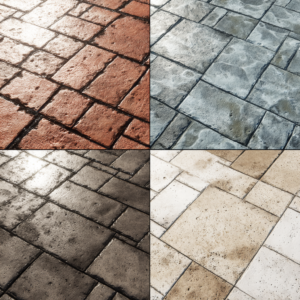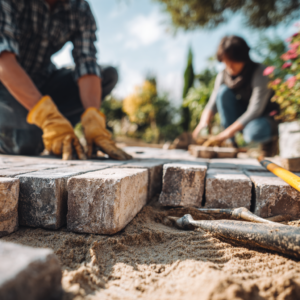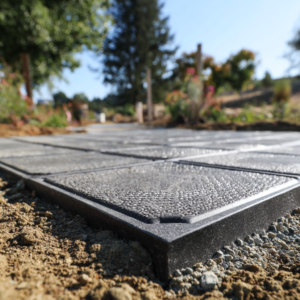Pool paver coping is the unsung hero of your pool area, providing both practical functionality and aesthetic charm. At the end of the day, it serves not only as a finishing touch for the dream outdoors but also as the perfect chance to secure the new area for daily use, keeping it safe and reliable in the long run.
In this guide, we’ll explore every facet of pool paver coping – from its essential purpose to the selection of materials, popular styles and edges, and the potential pitfalls of making the wrong choice.
Don’t miss: Porcelain Pavers vs. Travertine Pavers – Complete Guide
Jump to:
What is pool paver coping?
Pool paver coping – often referred to simply as pool coping – is the material or edging that is installed around the perimeter of a paver swimming pool. Its primary purpose is to provide a finished edge or border around the water, but it also serves several important functions, such as:
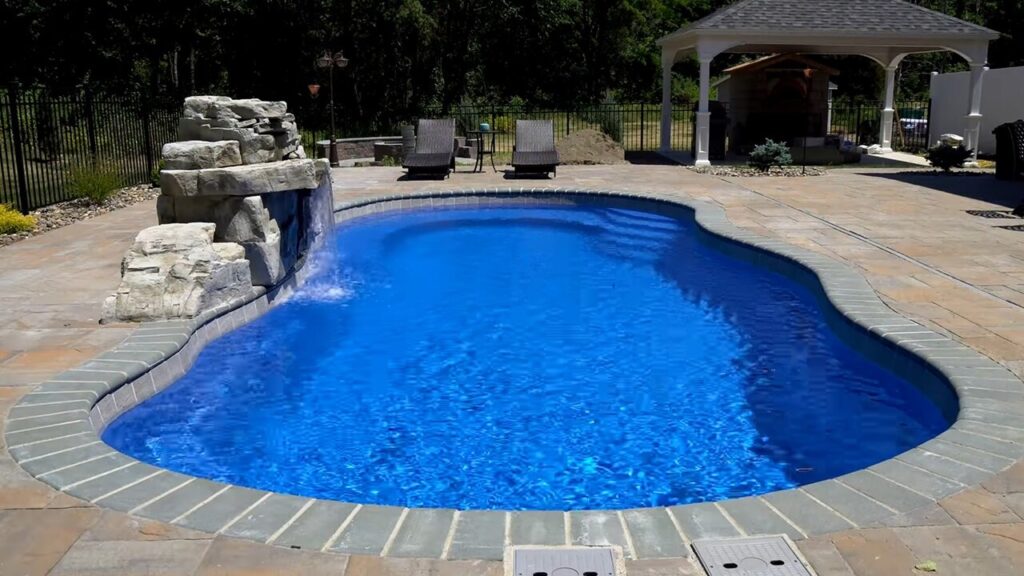
- Safety: Pool coping helps create a smooth and safe transition between the pool deck and the pool itself, which prevents tripping and provides a comfortable edge for swimmers to rest their arms on while in the water.
- Water Containment: Coping is designed to prevent water from splashing out of the pool and onto the pool deck. This helps direct water back into the pool and away from the surrounding area.
- Aesthetics: It can enhance the overall appearance of a pool area – for it comes in various materials, colors, and styles, allowing homeowners to choose options that complement the pool’s design and landscaping.
- Durability: Coping pavers are chosen for their durability and resistance to pool chemicals and water exposure. This helps ensure that the coping remains in good condition over time.
Choosing the right pavers for pool coping depends on your preferences, budget, and the overall aesthetic you want for your pool area. That said, each type of paver material available on the market has its advantages and considerations, so make sure to consult a hardscape expert near you to learn how to obtain the best results.
Porcelain Pavers
Porcelain pavers are a popular choice for pool coping (and several other paver projects, while we’re at it) due to their durability and aesthetics. Not only are they non-porous – which means no need for sealing, cutting down on maintenance costs – but they are resistant to water absorption, staining, and fading, making them ideal for a pool environment. Porcelain pavers come in various colors, textures, and sizes, allowing for versatile design options. They are also easy to clean. Just keep in mind that they can be more expensive than some other options.
Travertine Pavers
Travertine is a natural stone known for its beauty and classic appeal – but the selling point is its porous surface, which can provide a non-slip grip when wet, enhancing safety around the pool. Travertine comes in various earthy tones and can create a timeless and elegant look. However, it may require more maintenance than some other materials, as it can be susceptible to staining.
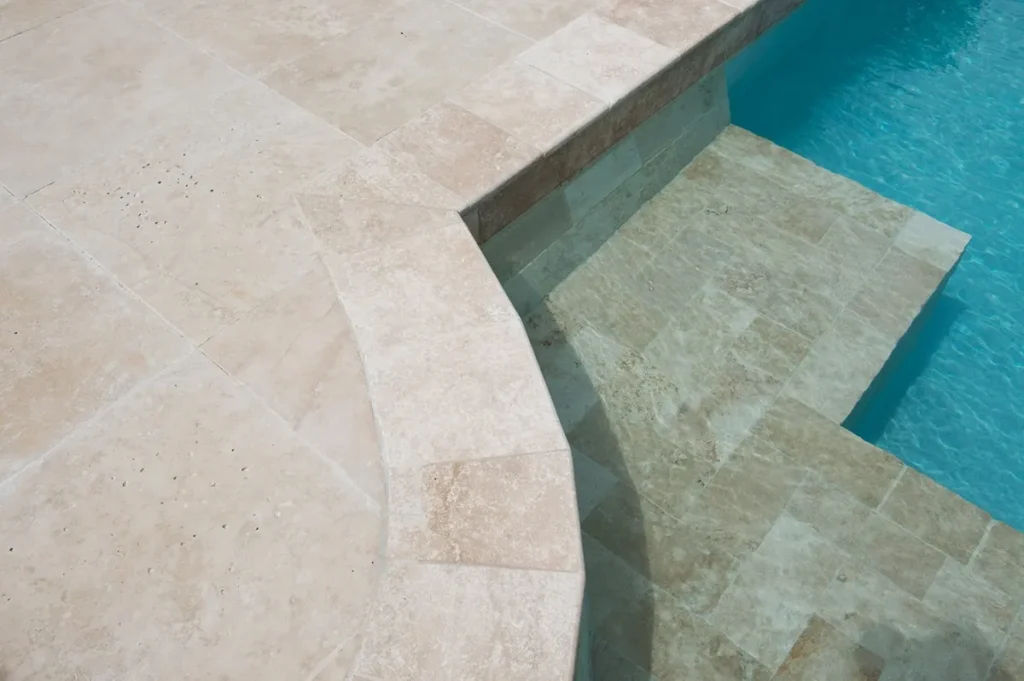
Brick Pavers
Brick pavers are a traditional and cost-effective choice for pool coping. They offer a classic and rustic appearance and can withstand varying weather conditions, being durable and providing good slip resistance. However, the range of colors and textures may be more limited compared to other materials.
Concrete Pavers
Concrete pavers are a versatile and customizable option that can be molded into various shapes, sizes, and textures to suit your design preferences. As a construction material, concrete is generally durable, offering good slip resistance for poolside applications. It is also cost-effective compared to some natural stone options, but its appearance may not be as luxurious as porcelain or travertine.
When choosing pavers for pool coping, consider factors such as the climate in your area, the amount of maintenance you’re willing to undertake, the aesthetic you desire, and your budget. Additionally – and that’s where professional assistance comes in again – it’s essential to ensure that the pavers you choose are installed correctly and securely to maintain their durability and safety in the long run.

What makes a good and bad pool coping?
Good pool coping enhances both the aesthetics and functionality of a swimming pool, while bad pool coping can lead to safety hazards and maintenance issues. Here are some key factors that distinguish good pool coping from bad pool coping:
- Safety: Good pool coping provides a safe transition between the pool deck and the pool itself. It should have a slip-resistant surface to minimize the risk of accidents, especially when it gets wet.
- Durability: The coping material should be durable and able to withstand exposure to water, sunlight, pool chemicals, and changing weather conditions. High-quality materials like porcelain, travertine, and properly sealed natural stone can offer excellent durability.
- Comfort: Coping should offer a comfortable edge for swimmers to rest their arms or lean against while in the pool. It should not have sharp edges or rough surfaces that could cause discomfort or injury.
- Maintenance: Coping should be relatively easy to clean and maintain. Materials that resist staining and are easy to clean, such as porcelain or sealed natural stone, are preferred.
- Proper Installation: Correct installation is crucial for good pool coping. It should be securely set in place to prevent shifting or settling over time. Properly installed coping should also allow for expansion and contraction due to temperature changes.
That said, a bad installation and choice of materials may cause:
- Safety Hazards: Coping with a slippery surface or uneven edges can pose safety hazards, increasing the risk of accidents and injuries around the pool.
- Lack of Durability: Materials that deteriorate quickly or are prone to cracking, chipping, or fading are considered bad choices. Inadequate coping may require frequent repairs or replacements.
- Uncomfortable Design: Coping with uncomfortable or sharp edges can be unpleasant for swimmers. Coping that doesn’t provide a comfortable resting place can detract from the pool experience.
- Difficult Maintenance: Coping that is challenging to clean or maintain can lead to frustration and additional costs. Materials that are prone to staining or discoloration may require frequent upkeep.
- Improper Installation: Wherever is improperly installed can shift, settle, or become unstable over time, leading to safety issues and the need for costly repairs.
What edges and styles of pool coping are the most popular?
In the end, the popularity of pool coping styles and edges can vary depending on factors such as regional preferences, current design trends, and personal aesthetics. However, some pool coping styles and edges tend to be more commonly favored on the market due to their versatility and timeless appeal. Check out the main ones below:
Bullnose Edge

The bullnose edge is one of the most popular and classic choices for pool coping. It features a smoothly rounded edge that provides a comfortable resting place for swimmers and a clean, finished look – and is available in various materials, including natural stone, concrete, and porcelain.
Square Edge
Square-edge coping is a straightforward choice that offers clean lines and a modern appearance. It works well with contemporary pool designs, for example, and can be made from materials like concrete or porcelain.
Beveled Edge
Beveled coping features a slight angle or bevel along the top edge, adding a touch of sophistication to the pool’s design. This provides a comfortable grip for swimmers while maintaining a sleek look.
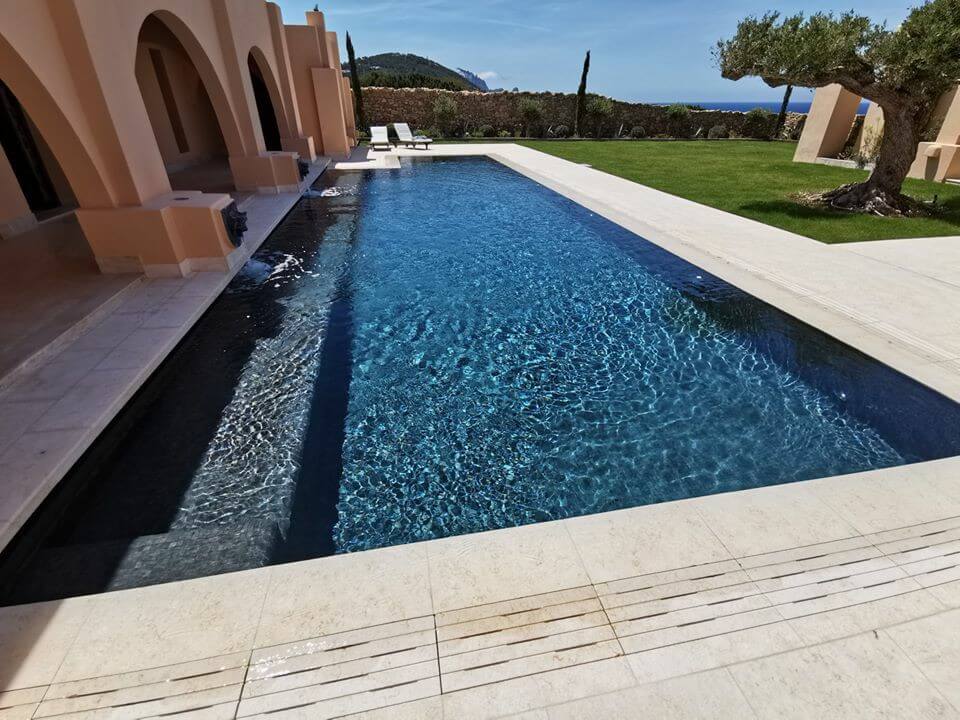
Remodel Coping
Remodel coping, as the name suggests, is designed to cover the existing coping of older pools during renovations. It typically includes an overhang that conceals the existing coping, giving the pool a refreshed look.
Should I install my pavers by myself?
As experts in the hardscape industry for years, no. DIY enthusiasts can probably tackle the majority of simpler paver projects, but the fact is that pool coping is a complex process that takes a lot of planning, logistics, and budget. This means that, unless you’re sure of what you’re doing, the task at hand will be hard, and the results won’t come to fruition the way you wish.
Read up on how to install paver coping in this article.
Any investment of this sort, after all, should be carefully considered and done to withstand the test of time. Some reasons to opt for professional services include:
- Expertise: Professional installers have experience and expertise in working with pavers and coping materials. They can ensure precise, safe, and aesthetically pleasing installations.
- Efficiency: Professionals can typically complete the project more quickly, minimizing disruption to your pool area.
- Warranty: Many professional installers offer warranties on their work, giving you peace of mind in case of any issues.
- Quality Supply: They can help you select high-quality coping materials and ensure they are installed correctly, which can extend the lifespan of your pool coping.
- Customization: If you have a unique or complex design in mind, experts can handle intricate details and patterns effectively.
- Permits and Regulations: Finally, pros are familiar with local building codes and permitting requirements, helping ensure your project complies with regulations.
Don’t hesitate to call for hardscape experts
We here at JS Brick have worked in countless poolside installations over our 23 years of experience in the hardscape business. We know up close the power and elegance of a good pool paver coping, regardless of the material chosen.

If you are around our area of activity – Sarasota County, in FL – you can get in contact anytime for a free estimate of our services. We can start helping you with your project today!
